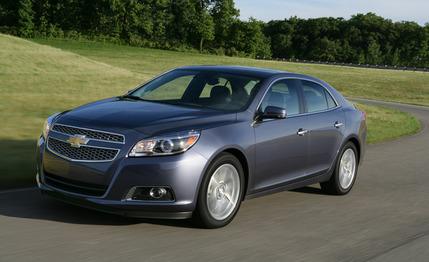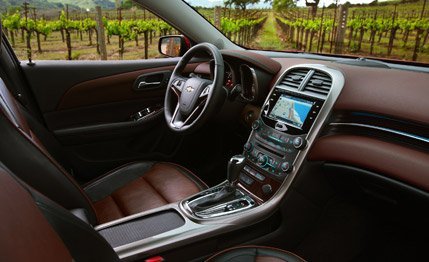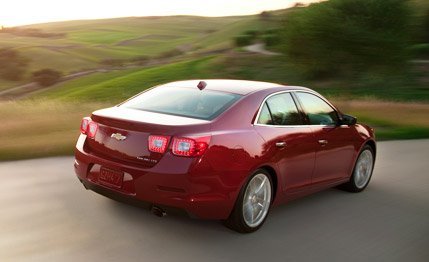 First Drive Review
First Drive Review
Most family-sedan drivers are perfectly happy with the base four-cylinder engine. Modern fours are generally smooth and quiet and can easily sustain 80 mph—or higher—on the highway, while delivering excellent fuel economy. But there are always customers who want more.
In the past, that meant an optional V-6. But while the Japanese entries in this segment still offer a six, some the freshest four-door buns from the oven are replacing those engines with turbocharged fours—the list includes the Hyundai Sonata, the Ford Fusion, and now the new Chevrolet Malibu.
Specifics as they relate to the ’Bu’s transplant are as follows: Out goes a port-injected 3.6-liter V-6 and in goes the latest 2.0-liter Ecotec turbo four, which is essentially the same engine as found in the Cadillac ATS. Although tighter intake and exhaust manifolds drop the power from 272 ponies in the ATS to 259 in the Malibu, that’s still 7 more than served up by the old V-6. And the Turbo’s 260 lb-ft of torque is up 9 and developed at 1700 rpm instead of 3200.

The big payoff, however, is fuel economy. The EPA numbers now read 21 mpg city and 30 highway—each up 4 mpg. At the same time, Chevy is claiming a 0-to-60-mph time of 6.3 seconds, a bit quicker than the V-6. We think that might be a skosh optimistic, but we’ll find out once we can get our test gear onboard.
After spending a few hours behind the wheel of the turbo model, we see little downside to the engine swap. There’s plenty of acceleration at any speed and the front-drive car puts the power down without much steering crosstalk. Buyers who live at higher elevations will love the change because a turbo engine loses far less power to thinner, high-altitude air.
Flooring the accelerator from a dead stop, however, reveals a little lag and a beat of delay before full thrust arrives. We noticed some of the same delayed action at 55 mph, when sixth gear drops engine revs to about 1500. If you need to take someone off the line—say, to snag that last parallel-parking spot in front of the daycare—a little brake torqueing will ensure that the boost is up when the traffic light turns green.
Otherwise, the turbocharged Malibu is much like its equally new-for-2013 siblings. That means it rides on the latest iteration of the General’s Epsilon architecture, with an attendant 4.5-inch reduction in wheelbase from before. Overall length remains about the same, however, and width and both front and rear tracks are all up by at least two inches.
Interior space is slightly increased compared to the 2012, as is trunk space, but rear legroom has shrunk by about an inch and taller passengers will not be happy in the back seat. Despite the loss of two cylinders, curb weight increases.

One benefit of the new platform is an even quieter cabin—and the old Malibu was very good in this regard. Wind noise is very low and road noise on smooth pavement is virtually non-existent. With decently weighted steering (the turbo gets its own, heavier tune) and a supple ride, this Malibu is an excellent long-distance cruiser. A revised front suspension imparts a bit more body control and liven handling a smidge compared to other Malibus, but the Ford Fusion and new Honda Accord are just two of its competitors that are more rewarding to pilot.
The only transmission is GM’s 6T70 six-speed automatic; it offers a manual mode that’s best avoided—gears are selected by a very awkward rocker switch atop the shift knob—but in drive mode it at least detects driver friskiness and slips into a sport calibration that does a fine job of selecting the right ratio. Sustained high revs bring out a faintly industrial engine note, but the sound is neither excessive nor raucous.
Last year, an LT V-6 ran $29,060 and an LTZ V-6 $30,960. In comparison, a turbocharged 2013 ’Bu can be had for $27,710 in LT trim and $30,925 in LTZ guise. The pricing is in line with the competition, which makes sense, as this turbocharged model might be the best Malibu—the 2.5-liter car and the woebegone Eco are the others—but it’s not worth a premium over the better choices in the segment.